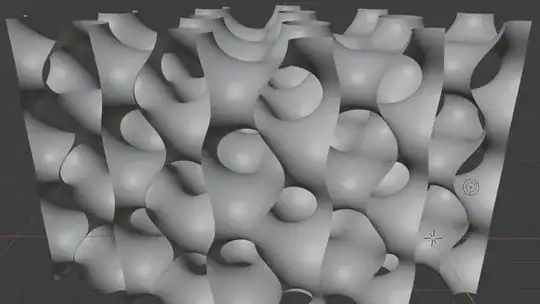I want to derive closed-form parametric expressions describing the Schwarz H minimal surface starting from the Weierstrass–Enneper parametrisation, much like Gandy et al. did for the Schwarz D surface and its associates (Schwarz P and gyroid). I have the W–E parametrisation from Sven Lidin (1988), Ring-like minimal surfaces, Journal of Physics 49, 421–427: $$x=\operatorname{Re}\int_w^1(1-t^2)R(t)\,dt$$ $$y=\operatorname{Re}\int_w^1i(1+t^2)R(t)\,dt$$ $$z=\operatorname{Re}\int_w^12tR(t)\,dt$$ $$R(t)=\left(\left(t^4+\frac{2(7s^2-4)}{(s+2)^2}t^2+\left(\frac{s-2}{s+2}\right)^2\right)\left(t^2+\frac{s+1}{s-1}\right)(t^2-1)\right)^{-1/2}$$ $s$ is a free parameter in $(0,1)$ determining the unit cell height and the domain of integration is $\operatorname{Re}w\ge0,\operatorname{Im}w\ge0,\left|w+\frac1{\sqrt3}i\right|\le\frac2{\sqrt3}$. (The equations presented in the paper are not quite correct, but the presented derivation is sound, so I re-did the derivation. The paper also uses $E\in(0,1)$ as the free parameter where $s^2+E^2=1$; my formulation conveniently avoids square roots in the coefficients.)

While I can certainly numerically integrate each coordinate, it's quite slow. The problem I'm encountering here is that the integrals do not appear easily reducible to simpler, faster forms. Of course we can substitute $u=t^2$ to get $$x=\frac12\operatorname{Re}\int_{w^2}^1\frac{1-u}{\sqrt uS(u)}\,du\tag{*}$$ $$y=\frac12\operatorname{Re}\int_{w^2}^1i\frac{1+u}{\sqrt uS(u)}\,du\tag{*}$$ $$z=\operatorname{Re}\int_{w^2}^1\frac1{S(u)}\,du$$ $$S(u)=\sqrt{\left(u^2+\frac{2(7s^2-4)}{(s+2)^2}u+\left(\frac{s-2}{s+2}\right)^2\right)\left(u+\frac{s+1}{s-1}\right)(u-1)}$$ and the new $z$ integral is obviously elliptic*, but the $x$ and $y$ integrals are hyperelliptic and I don't see how to proceed from here. When it came to the Schwarz D/G/P family, where $R(t)=(t^8-14t^4+1)^{-1/2}$ and $S(u)=\sqrt{u^4-14u^2+1}$, Gandy et al. reduced the hyperelliptic integrals to elliptic ones by the transformation $q=u+\frac1u$, but that requires the quartic under the root in $S(u)$ to be palindromic, which is not the case for the Schwarz H surface.
Can the hyperelliptic $x$ and $y$ integrals after the $u=t^2$ substitution (the ones marked with $*$) be solved in any way not involving straight numerical integration, whether by elliptic integrals, hypergeometric functions or otherwise? What transformations must be made to accomplish this? If this is not possible, can I transform it into something like Carlson's symmetric form for faster numerical integration?
*$z$ integral using elliptic integrals, Mathematica/mpmath convention: $$z=gF(\varphi,m)$$ $$m=\frac12\left(1+\sqrt{\frac3{4-s^2}}\right)$$ $$g=\frac1{\sqrt{AB}},A=\frac{4s}{s+2},B=\frac{2s}{1-s}\sqrt{\frac{3(2-s)}{s+2}}$$ $$\varphi=\cos^{-1}\frac{J-K}{J+K},J=2(1+s-w^2+sw^2),K=(1-w^2)\sqrt{3(4-s^2)}$$
The title was inspired by this other question of mine.